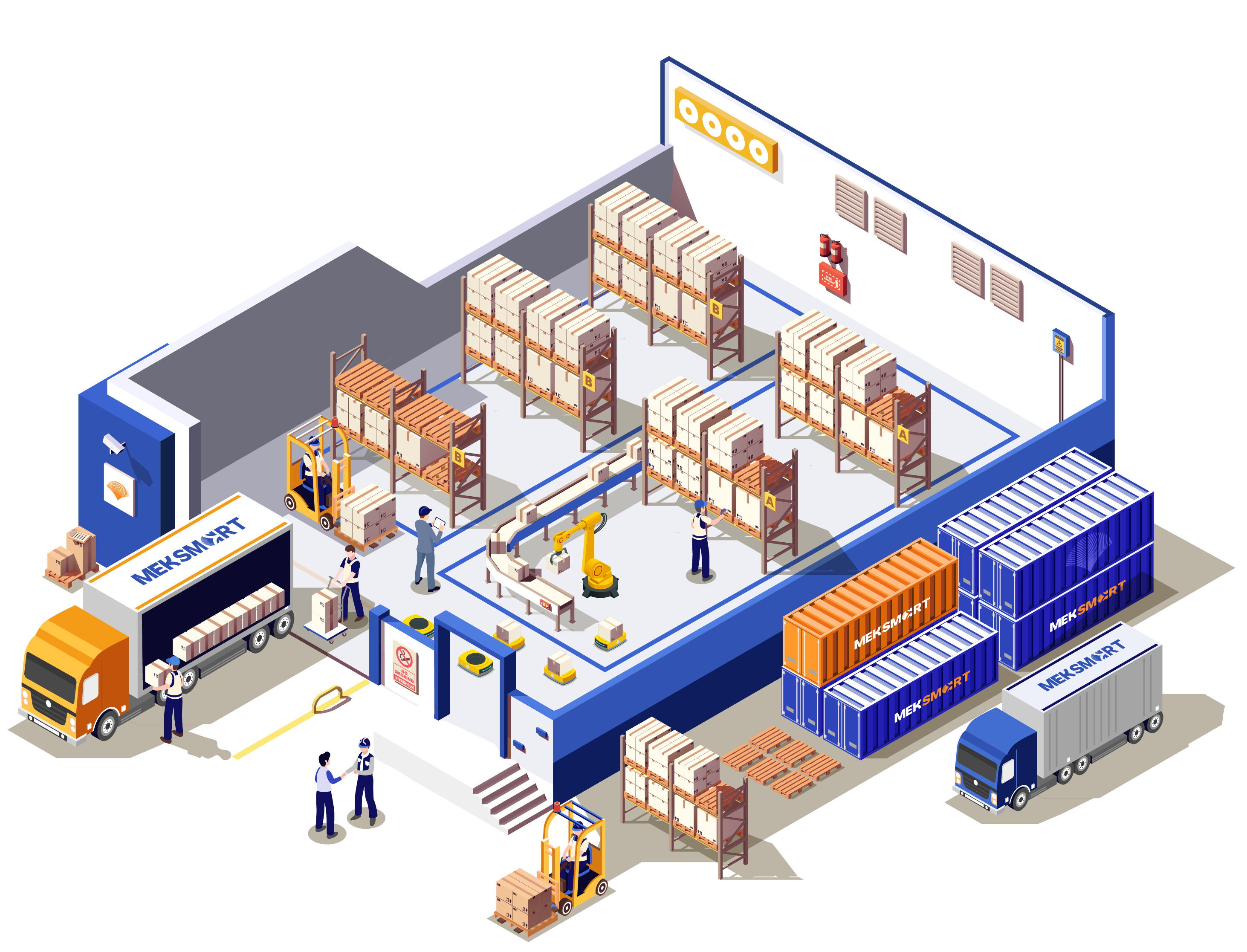MEKSMART
GENERAL NEWS
Author:
Update: 14/09/2022
KPIS IMMEDIATELY IN HOUSEHOLD MANAGEMENT
Warehouse Management always faces many challenges: Customers need to get the products they order with quality service. Employees deserve a healthy and non-boring working environment. Suppliers should have access to immediate inbound freight routing information. Facing these challenges all at once can be overwhelming, but Warehouse Managers can simplify processes by tracking these top KPIs:
1. Receiving and Put-Away KPIs
- These are KPIs of goods received and stored.
+ Workforce Utilization – Optimizing human resources
+ Volume per employee – Volume of goods per employee in charge
+ Cost per item – Cost per product
+ Accuracy and timeliness of delivery – Accuracy and timeliness of delivery
+ Labor costs – Labor costs
+ Backorder rate – The percentage of orders sent but not yet delivered
- Managers must track the cost of each order item, the accuracy and timeliness of inbound shipping, and the labor costs associated with receiving the goods. These KPIs can be leveraged to improve supplier relationships and increase employee productivity.
2. Storage KPIs
- These are KPIs about warehouse storage
- You need to track inventory turnover, inventory costs and average inventory value when managing a warehouse. The 2 most important storage KPIs are calculated from the following formulas:
Inventory Turnover = The Cost of Total Goods Sold During a Period / Average Inventory Value
- High inventory turnover is a good sign for the enterprise's warehouse. These KPIs allow you to assess and control purchasing and product demand, and forecast demand to keep your inventory at optimal levels.
Carrying Cost of Inventory = Inventory Carrying Rate (How Long a Product Stays in the Warehouse) * Average Inventory Value
3. Picking and Packing KPIs
- These are the KPIs for picking and packing.
- Most managers consider picking to be one of the most expensive and most difficult processes because it requires a lot of labor. Picking and packing operations are typically more complex than other stages, and greatly affect organizational output because of their close relationship to customer satisfaction.
- With these KPIs, You can measure accuracy, picking and packing speed, and perfect pick line rate (pick line: number of orders of an item taken at once)
+ Average number of items picked per employee: the average number of items picked by each employee
+ The total value of picks: Total value of goods taken
+ Cost per line item: cost per item of goods
+ Labor costs: Labor costs
+ Cost of packaging: cost of packaging
+ Order cycle time: Time for an order cycle.
4. Shipping KPIs
- These are the KPIs about shipping.
- These KPIs may seem similar to the aforementioned picking and packing KPIs, however, these metrics will focus more on the total quantity of goods shipped than on the expected number of items shipped. For example, the company shipped 100 products but 150 products had to be shipped on schedule, so you did not meet your Shipping KPIs, indicating delays or warehouse operations issues.
+ Shipping KPIs = Total Orders Shipped / Number of Planned Orders.
- An ideal result is equal to 1. An increasing result means the operation is getting high efficiency, and conversely, a decreasing result indicates a decrease in productivity.
5. Reverse Logistics KPIs
- These are reverse logistics KPIs.
- Reverse Logistics KPIs are indicators that revolve around products that are recycled or need to be returned from consumers back to the business. There are many indicators of reverse logistics, but the most important is the rate of return.
+ Rate of return = Number of units returned / Total units sold.
- As results increase, businesses need to review the quality of their products.
6. Inventory Accuracy
- This is the accuracy of the inventory.
These are important KPIs for the warehouse because if inventory tracking isn't accurate, your costs will skyrocket and your customer satisfaction levels will drop. If you rely solely on Excel or manual processes, inventory accuracy is low and you will most likely encounter duplicate orders or re-manufacturing of already-existing parts due to incorrect quantities.
- One solution to control inventory is to choose a system that uses barcodes to track goods. Some warehouses are using barcode systems that integrate with existing computerized maintenance management systems (CMMS) to improve control by providing a framework for managing inventory, supplies, and other items. other warehouse materials.
In addition, some CMMS programs have the ability to track shipments, manage orders, and track stock and inventory levels.
7. Equipment KPIs
- These are the KPIs about the device.
Any warehouse manager understands the value of work equipment. Equipment should be monitored for possible maintenance and extended uptime.
- These KPIs are calculated by dividing the current time used since the last maintenance by the average time between maintenance. The results show how long devices can last before needing maintenance.
8. The Big Picture – An overview
Warehouse managers and Supply Chain executives should also track replenishment rates and average number of late deliveries by vendors. By tracking all these KPIs, the manager can keep control of the warehouse operations and be ready to operate the omni-channel distribution channel.
- The following summary table, produced by NewCastle Systems, introduces a few other KPIs that can be considered and tracked to improve the organization's warehouse operations.
Internal performance KPIs
KPIs về hoạt động nội bộ |
KPIs đối với nhà cung cấp |
KPIs về khách hàng |
|
Perfect Orders On-Time Deliveries Inventory Accuracy Inventory Turnover Ratio Order Cycle Time Order Entry Accuracy Workforce Utilization Shipping Accuracy Order Fill rate Customer Satisfaction |
Inbound Cost/ Order Value On-Time Deliveries Lead Time Fill Rate IT / Technology Resources Service Flexibility Attitude Return Policy Value Added Service VMI Capabilities Ethics/ Compliance |
Profitability Sales Volume Growth Potential Credit / Payment History Shared Strategic Vision Return rate Order Frequency Loyalty Cost to Serve Competitive Pressure Hassle to Serve |
According to cerasis.com & business.com













